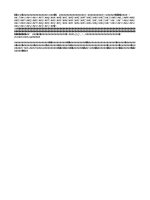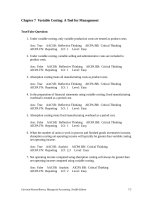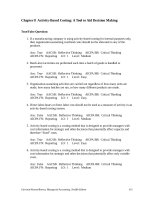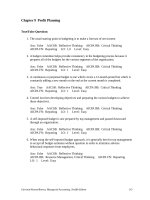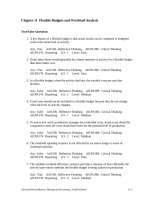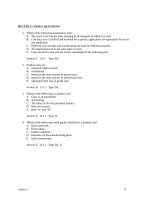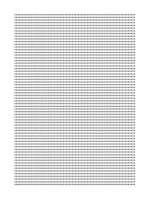Test bank managerial accounting by garrison 13e chapter 04
Bạn đang xem bản rút gọn của tài liệu. Xem và tải ngay bản đầy đủ của tài liệu tại đây (5.17 MB, 8,129 trang )
��#ࡱ#�################>###�� #############D###}!##########ࡱ!######����####:!
##;!##<!##=!##>!##?!##@!##A!##B!##C!##D!##E!##F!##G!##H!##I!##J!##K!##L!##M!##N!
##O!##P!##Q!##R!##S!##T!##U!##V!##W!##X!##Y!##Z!##[!##\!##]!##^!##_!##`!##a!##b!
##c!##d!##e!##f!##g!##h!##i!##j!##k!##l!##m!##n!##o!##p!##q!##r!##s!##t!##u!##v!
##w!##x!##y!##z!##{!##|!##�!
##������������������������������������������������������������������������������
��������������������������������������������������������������������������������
��������##` ###�#�###############X�!###bjbj\.\.#####################A�!
#>D##>D##u$######
#######################��##########��##########��##################�#####�######
#�###�#######�#######�#######�#######�#######################�S######�S######�S#
#8###(T##<###dY###o##########��##�###��######��##(###��######��######��######��#
#####��##
###��######��######��######��######��######��######��######��######R�##h###�###h
###��###
##################�#######��######################��######��######��######��####
##��##############�#######�#######��##############��#######�##R###��######��####
##��######��##�###�#######��######�#######��######��##############��############
##########################################��######��##############��######��##j#
##C###�###�#######�#############################################################
##{#######��######��##
###p���#U�#########�S######|
�##\###�###2###############��##T�##H###��######1###J###"#######��##�###"###d###{
###############################################################################"
###############�#######{###�###################��###############################
#######################��######��######��######��######��#######################
###############t�##X###################################��######��######��######�
�######��######��######��######��###################################�##
�##�##########################
�##############################�#######�#######�#######�#######�#######�#######�
���######
################################################################################
################################################################################
################################################################################
################################################################################
################################################################################
################################################################################
################################################################################
###################True/False Questions 1.
In a process costing system, the
costs of one processing department become part of the costs of the next
processing department.
Ans:��True
AACSB:��Reflective�Thinking
AICPA�BB:��Critical�Thinking
AICPA�FN:��Reporting
LO:��1
Level:��Easy
2.
The equivalent units
of production will be the same under the weighted-average and the FIFO method if
there is no beginning work in process inventory.
Ans:��True
AACSB:��Reflective�Thinking
AICPA�BB:��Critical�Thinking
AICPA�FN:��Reporting
Appendix:��4A
LO:��2,5
Level:��Medium
3.
Under the weighted-average method, the
equivalent units used to compute the unit costs of ending inventories relate
only to work done during the current period.
Ans:��False
AACSB:��Analytic
AICPA�BB:��Critical�Thinking
AICPA�FN:��Reporting
LO:��2
Level:��Hard 4.
In order to equitably allocate costs in a process
costing system, dissimilar products are restated in terms of equivalent units by
weighting the number of units produced by their market values.
Ans:��False
AACSB:��Reflective�Thinking
AICPA�BB:��Critical�Thinking
AICPA�FN:��Reporting
LO:��2
Level:��Easy
5.
In a process costing system, units transferred to the
next processing department are presumed to be 100% complete with respect to the
work performed by the transferring department.
Ans:��True
AACSB:��Reflective�Thinking
AICPA�BB:��Critical�Thinking
AICPA�FN:��Reporting
LO:��2
Level:��Easy
6.
Under a weightedaverage process costing system when all materials are added at the beginning of
the production process, the equivalent units for materials is equal to the units
completed and transferred out.
Ans:��False
AACSB:��Analytic
AICPA�BB:��Critical�Thinking
AICPA�FN:��Reporting
LO:��2
Level:��Hard
7.
In calculating cost per equivalent unit under the weighted-average
method, prior period costs are combined with current period costs.
Ans:��True
AACSB:��Reflective�Thinking
AICPA�BB:��Critical�Thinking
AICPA�FN:��Reporting
LO:��3
Level:��Easy
8.
The equivalent units of production for a department
using the FIFO process costing method is equal to the number of units completed
plus the equivalent units in the ending inventory.
Ans:��False
AACSB:��Analytic
AICPA�BB:��Critical�Thinking
AICPA�FN:��Reporting
Appendix:��4A
LO:��5
Level:��Hard
9.
The
step-down method of cost allocation is more accurate than the direct method
since the step-down method considers services that service departments provide
to each other.
Ans:��True
AACSB:��Reflective�Thinking
AICPA�BB:��Critical�Thinking
AICPA�FN:��Reporting
Appendix:��4B
LO:��8,9
Level:��Easy
10.
The step-down method and the direct method
of cost allocation will result in the same amount of service department cost
being allocated to a given operating department, although the step-down method
is easier to apply than the direct method.
Ans:��False
AACSB:��Reflective�Thinking
AICPA�BB:��Critical�Thinking
AICPA�FN:��Reporting
Appendix:��4B
LO:��8,9
Level:��Medium 11.
The
order in which the costs of service departments are allocated will affect the
amounts allocated to an operating department when the direct method is used.
Ans:��False
AACSB:��Analytic
AICPA�BB:��Critical�Thinking
AICPA�FN:��Reporting
Appendix:��4B
LO:��8
Level:��Medium
12.
The units in beginning work in process
inventory plus the units started into production must equal the units
transferred out of the department plus the units in ending work in process
inventory.
Ans:��True
AACSB:��Reflective�Thinking
AICPA�BB:��Critical�Thinking
AICPA�FN:��Reporting
LO:��10
Level:��Easy
13.
In a process costing system, direct labor cost combined with
manufacturing overhead cost is known as conversion cost.
Ans:��True
AACSB:��Reflective�Thinking
AICPA�BB:��Critical�Thinking
AICPA�FN:��Reporting
LO:��10
Level:��Easy
14.
Process costing is employed in industries that produce
basically homogeneous products such as bricks, flour, or cement but would not be
appropriate for assembly-type operations such as those that manufacture
computers.
Ans:��False
AACSB:��Analytic
AICPA�BB:��Critical�Thinking
AICPA�FN:��Reporting
LO:��10
Level:��Medium
15.
Process costing is used where many different products
are produced each period to customer specifications.
Ans:��False
AACSB:��Reflective�Thinking
AICPA�BB:��Critical�Thinking
AICPA�FN:��Reporting
LO:��10
Level:��EasyMultiple Choice Questions
16.
Which of the following
statements related to job-order costing and process costing are true? A)
Under both costing methods, manufacturing overhead costs are included in
the computation of unit product costs.
B)
Under both costing methods, the
journal entry to record the completion of production will involve crediting a
work in process account.
C)
Under both costing methods, the journal
entry to record the cost of goods sold will involve crediting the finished goods
account.
D)
All of the above are true.
Ans:��D
AACSB:��Analytic
AICPA�BB:��Critical�Thinking
AICPA�FN:��Reporting
LO:��1
Level:��Hard
17.
The completion of goods is recorded as a decrease in the work in
process inventory account when using:
#Job-order costing#Process
costing##A)#Yes#No##B)#Yes#Yes##C)#No#Yes##D)#No#No##
Ans:��B
AACSB:��Reflective�Thinking
AICPA�BB:��Critical�Thinking
AICPA�FN:��Reporting
LO:��1
Level:��Easy
Source:��CPA,�adapted
18.
In process costing, a separate work in process account is kept for each:
A)
individual order. B)
equivalent unit. C)
processing
department. D)
cost category (i.e., materials, conversion cost).
Ans:��C
AACSB:��Reflective�Thinking
AICPA�BB:��Critical�Thinking
AICPA�FN:��Reporting
LO:��1
Level:��Easy
19.
The weighted-average method of process costing differs
from the FIFO method of process costing in that the weighted-average method: A)
does not consider the degree of completion of beginning work in process
inventory when computing equivalent units of production.
B)
considers
ending work in process inventory to be fully complete.
C)
will always
yield a higher cost per equivalent unit. D)
All of the above.
Ans:��A
AACSB:��Analytic
AICPA�BB:��Critical�Thinking
AICPA�FN:��Reporting
Appendix:��4A
LO:��2,3,5,6
Level:��Hard
20.
Which of the following are needed to compute equivalent units for
conversion costs under the weighted-average method of process costing?
#Percentage completion of beginning work in process#Percentage completion of
ending work in process##A)#Yes#Yes##B)#No#Yes##C)#Yes#No##D)#No#No##
Ans:��B
AACSB:��Reflective�Thinking
AICPA�BB:��Critical�Thinking
AICPA�FN:��Reporting
LO:��2
Level:��Easy
21.
Malcolm Company uses
a weighted-average process costing system. All materials at Malcolm are added at
the beginning of the production process. The equivalent units for materials at
Malcolm would be the sum of: A)
units in ending work in process and the
units started.
B)
units in beginning work in process and the units
started.
C)
units in ending work in process and the units started and
completed. D)
units in beginning work in process and the units started and
completed.
Ans:��B
AACSB:��Analytic
AICPA�BB:��Critical�Thinking
AICPA�FN:��Reporting
LO:��2
Level:��Hard
22.
In the computation of costs per equivalent unit, the
weighted-average method of process costing considers:A)
costs incurred during
the current period only.
B)
costs incurred during the current period
plus cost of ending work in process inventory. C)
costs incurred during the
current period plus cost of beginning work in process inventory. D)
costs
incurred during the current period less cost of beginning work in process
inventory.
Ans:��C
AACSB:��Reflective�Thinking
AICPA�BB:��Critical�Thinking
AICPA�FN:��Reporting
LO:��3
Level:��Easy
Source:��CPA,�adapted
23.
Which of the following are needed to compute the cost per equivalent
unit for materials under the weighted-average method of process costing?
#Material cost assigned to beginning work in process last period#Material
cost added to production during the current
period##A)#Yes#Yes##B)#No#Yes##C)#Yes#No##D)#No#No##
Ans:��A
AACSB:��Reflective�Thinking
AICPA�BB:��Critical�Thinking
AICPA�FN:��Reporting
LO:��3
Level:��Medium
24.
Under which of the
following conditions will the FIFO method of process costing result in the same
amount of cost being transferred to the next department as the weighted-average
method?
A)
When the beginning and ending inventories are each fifty
percent complete. B)
When there is no beginning inventory.
C)
When
there is no ending inventory. D)
When units in the beginning inventory are
all completed and transferred at the same time.
Ans:��B
AACSB:��Analytic
AICPA�BB:��Critical�Thinking
AICPA�FN:��Reporting
Appendix:��4A
LO:��4,7
Level:��Hard
Source:��CMA,�adapted 25.
In
order to compute equivalent units of production using the FIF0 method of process
costing, work for the period must be broken down into parts:
A)
completed
during the period and units in ending inventory.
B)
completed from
beginning inventory, started and completed during the month, and units in ending
inventory. C)
started during the period and units transferred out during the
period.
D)
processed during the period and units completed during the
period.
Ans:��B
AACSB:��Analytic
AICPA�BB:��Critical�Thinking
AICPA�FN:��Reporting
Appendix:��4A
LO:��5
Level:��Medium
Source:��CPA,�adapted
26.
Which of the following methods of allocating service departments
take into account all of the effects of interdepartmental services?
#Direct#Step-Down##A)#Yes#Yes##B)#Yes#No##C)#No#Yes##D)#No#No##
Ans:��D
AACSB:��Analytic
AICPA�BB:��Critical�Thinking
AICPA�FN:��Reporting
Appendix:��4B
LO:��8,9
Level:��Medium 27.
All of the following
statements are correct when referring to process costing except: A)
Process
costing would be appropriate for a jeweler who makes custom jewelry to order.
B)
A process costing system has the same basic purposes as a job-order
costing system.
C)
Units produced are indistinguishable from each other.D)
Costs are accumulated by department.
Ans:��A
AACSB:��Reflective�Thinking
AICPA�BB:��Critical�Thinking
AICPA�FN:��Reporting
LO:��10
Level:��Medium 28.
For which of the
following would it be best to use an operation costing system?
A)
home
remodeling B)
automobile production
C)
cement used for roadways
D)
trash bags used for yard waste
Ans:��B
AACSB:��Analytic
AICPA�BB:��Critical�Thinking
AICPA�FN:��Reporting
LO:��10
Level:��Medium
29.
Health Beverage Company uses a process costing system to collect
costs related to the production of its celery flavored cola. The cola is first
processed in a Mixing Department at Health and is then transferred out and
finished up in the Bottling Department. The finished cases of cola are then
transferred to Finished Goods Inventory. The following information relates to
Health's two departments for the month of January:
##Mixing#Bottling###Cases of cola in work in process, January 1
#10,000#3,000###Cases of cola completed/transferred out during January
#77,000#?###Cases of cola in work in process, January 31
#4,000#8,000##
How many cases of cola were completed and transferred to Finished
Goods Inventory during January?
A)
66,000
B)
71,000
C)
72,000
D)
74,000
Ans:��C
AACSB:��Analytic
AICPA�BB:��Critical�Thinking
AICPA�FN:��Reporting
LO:��1
Level:��Medium
Solution:#To solve for units
transferred:####+ Work in process, beginning
#3,000###+ Units started into
production during the month
#77,000#########################################################################
#####################" #W#o#r#k# #i#n# #p#r#o#c#e#s#s#,# #e#n#d#i#n#g#
###�#�#8#,#0#0#0#######=# #U#n#i#t#s# #c#o#m#p#l#e#t#e#d# #a#n#d#
#t#r#a#n#s#f#e#r#r#e#d# #o#u#t# #d#u#r#i#n#g# #t#h#e# #m#o#n#t#h#
###7#2#,#0#0#0######
##
#3#0#.#
#T#h#e# #A#s#s#e#m#b#l#y# #D#e#p#a#r#t#m#e#n#t#
#s#t#a#r#t#e#d# #t#h#e# #m#o#n#t#h# #w#i#t#h# #8#3#,#0#0#0# #u#n#i#t#s# #i#n#
#i#t#s# #b#e#g#i#n#n#i#n#g# #w#o#r#k# #i#n# #p#r#o#c#e#s#s#
#i#n#v#e#n#t#o#r#y#.# #A#n# #a#d#d#i#t#i#o#n#a#l# #3#3#4#,#0#0#0# #u#n#i#t#s#
#w#e#r#e# #t#r#a#n#s#f#e#r#r#e#d in from the prior department during the month
to begin processing in the Assembly Department. There were 34,000 units in the
ending work in process inventory of the Assembly Department.
How many
units were transferred to the next processing department during the month?
A)
417,000
B)
285,000
C)
451,000
D)
383,000
Ans:��D
AACSB:��Analytic
AICPA�BB:��Critical�Thinking
AICPA�FN:��Reporting
LO:��1
Level:��Easy
Solution:#To solve
for units transferred:####+ Work in process, be#g#i#n#n#i#n#g#
###8#3#,#0#0#0#######+# #U#n#i#t#s# #s#t#a#r#t#e#d# #i#n#t#o#
#p#r#o#d#u#c#t#i#o#n# #d#u#r#i#n#g# #t#h#e# #m#o#n#t#h#
###3#3#4#,#0#0#0########" #W#o#r#k# #i#n# #p#r#o#c#e#s#s#,# #e#n#d#i#n#g#
###�#�#3#4#,#0#0#0#######=#U#n#i#t#s# #c#o#m#p#l#e#t#e#d# #a#n#d#
#t#r#a#n#s#f#e#r#r#e#d# #o#u#t# #d#u#r#i#n#g# #t#h#e# #m#o#n#t#h#
###3#8#3#,#0#0#0######
##
#3#1#.#
#C#o#l#b#y# #C#o#m#p#a#n#y# #h#a#s# #a# #p#r#o#c#e#s#s#
#c#o#s#t#i#n#g# #s#y#s#t#e#m# #i#n# #w#h#i#c#h# #t#h#e# #w#e#i#g#h#t#e#d##a#v#erage method is used. The company adds all materials at the beginning of
the process in the Molding Department, which is the first of two stages of its
production process. Information concerning the materials used in the Molding
Department during March is as follows:
##Units#Materials Costs###Work
in process at March 1
#22,000#$11,000###Units started during March
#90,000#$46,120###Units completed and transferred to next department
during March
#97,000###
What was the materials cost of the work in
process inventory at March 31?
A)
$11,220
B)
$7,500
C)
$5,100
D)
$7,650
Ans:��D
AACSB:��Analytic
AICPA�BB:��Critical�Thinking
AICPA�FN:��Reporting
LO:��2,3
Level:��Medium
Source:��CPA,�adapted
beginning
Solution:#To solve for ending work in process:####+ Work in process,
#22,000###+ Units started into production during the month
#90,000#########################################################################
####################################################################"
#U#n#i#t#s# #c#o#m#p#l#e#t#e#d# #a#n#d# #t#r#a#n#s#f#e#r#r#e#d# #o#u#t#
#d#u#r#i#n#g# #t#h#e# #m#o#n#t#h# ###9#7#,#0#0#0#######=# #W#o#r#k# #i#n#
#p#r#o#c#e#s#s#,# #e#n#d#i#n#g#
###1#5#,#0#0#0########E#q#u#i#v#a#l#e#n#t#
#u#n#i#t#s# #o#f#
#p#r#o#d#u#c#t#i#o#n###########M#a#t#e#r#i#a#l#s#######T#r#a#n#s#f#e#r#r#e#d#
#t#o# #n#e#x#t# #d#e#p#a#r#t#m#e#n#t#
###9#7#,#0#0#0# #######E#n#d#i#n#g#
#w#o#r#k# #i#n# #p#r#o#c#e#s#s# #(#m#a#t#e#r#i#a#l#s#:# #1#5#,#0#0#0#
#u#n#i#t#s# #�# #1#0#0#%# #c#o#m#p#l#e#t#e#)# ##�15,000 ###Equivalent units of
production #112,000 #######Cost per Equivalent Unit#####Materials###Cost of
beginning work in process
#$11,000 ###Cost added during the period #�46,120
###Total cost (a) #$57,120 #######Equivalent units of production (b)
#112,000
###Cost per equivalent unit, (a) � (b)
#$0.51 ########Materials###Ending work
in process inventory:####Equivalent units of production (materials: 15,000 units
� 100% complete; conversion: 15,000 units � % complete)
#15,000 ###Cost per
equivalent unit
#$0.51 ###Cost of ending work in process inventory
#$7,650
##
32.
Barnett Company uses the weighted-average method in its process
costing system. The company adds materials at the beginning of the process in
Department M. Conversion costs were 75% complete with respect to the 4,000 units
in work in process at May 1 and 50% complete with respect to the 6,000 units in
work in process at May 31. During May, 12,000 units were completed and
transferred to the next department. An analysis of the costs relating to work in
process at May 1 and to production activity for May follows:
##Materials#Conversion###Work in process 5/1
#$13,800#$3,740###Costs added
during May #$42,000#$26,260##
The total cost per equivalent unit for
May was:
A)
$5.02 B)
$5.10 C)
$5.12 D)
$5.25
Ans:��B
AACSB:��Analytic
AICPA�BB:��Critical�Thinking
AICPA�FN:��Reporting
LO:��2,3
Level:��Medium
Solution:#Equivalent
units of production#######Materials#Conversion####Transferred to next department
#12,000 #12,000 ####Ending work in process (materials: 6,000 units � 100%
complete; conversion: 6,000 units � 50% complete)
#�6,000 #�3,000
####Equivalent units of production #18,000 #15,000 ##########Cost per
Equivalent Unit#######Materials#Conversion#Total###Cost of beginning work in
process
#$13,800 #$�3,740 ####Cost added during the period
#�42,000
#�26,260 ####Total cost (a) #$55,800 #$30,000 ##########Equivalent units of
production (b)
#18,000 #15,000 ####Cost per equivalent unit, (a) � (b)
#$3.10 #$2.00 #$5.10 ##
33.
Maurice Company uses the weighted-average method in its process
costing system. The company adds materials at the beginning of the process in
the Forming Department, which is the first of two stages of its production
process. Information concerning the materials used in the Forming Department in
April follows:
##Units#Materials Costs###Work in process at April 1
#12,000#$6,000###Units started during April
#100,000#$51,120###Units
completed and transferred to next department during April #88,000###
What was the materials cost of the work in process at April 30? A)
$6,120
B)
$11,040
C)
$12,000
D)
$12,240
Ans:��D
AACSB:��Analytic
AICPA�BB:��Critical�Thinking
AICPA�FN:��Reporting
LO:��2,3
Level:��Medium
Source:��CPA,�adapted
beginning
Solution:#To solve for ending work in process:####+ Work in process,
#12,000###+ Units started into production during the month
#100,000########################################################################
####################" #U#n#i#t#s# #c#o#m#p#l#e#t#e#d# #a#n#d#
#t#r#a#n#s#f#e#r#r#e#d# #o#u#t# #d#u#r#i#n#g# #t#h#e# #m#o#n#t#h#
###�#8#8#,#0#0#0#######=# #W#o#r#k# #i#n# #p#r#o#c#e#s#s#,# #e#n#d#i#n#g#
###�#2#4#,#0#0#0########E#q#u#i#v#a#l#e#n#t# #u#n#i#t#s# #o#f#
#p#r#o#d#u#c#t#i#o#n###########M#a#t#e#r#i#a#l#s#######T#r#a#n#s#f#e#r#r#e#d#
#t#o# #n#e#x#t# #d#e#p#a#r#t#m#e#n#t#
###8#8#,#0#0#0# #######E#n#d#i#n#g#
#w#o#r#k# #i#n# #p#r#o#c#e#s#s# #(#m#a#t#e#r#i#a#l#s#:# #2#4#,#0#0#0#
#u#n#i#t#s# #�# #1#0#0#%# #c#o#m#p#l#e#t#e#)
#�24,000 ###Equivalent units of
production #112,000 #######Cost per Equivalent Unit#####Materials###Cost of
beginning work in process
#$�6,000 ###Cost added during the period #�51,120
###Total cost (a) #$57,120 #######Equivalent units of production (b)
#112,000
###Cost per equivalent unit, (a) � (b)
#$0.51 ########Materials###Ending work
in process inventory:####Equivalent units of production (materials: 24,000 units
� 100% complete) #24,000 ###Cost per equivalent unit #$0.51 ###Cost of ending
work in process inventory
#$12,240 ##
34.
Destry Company uses the weighted-average method in its process
costing system. The first processing department, the Welding Department, started
the month with 10,000 units in its beginning work in process inventory that were
30% complete with respect to conversion costs. The conversion cost in this
beginning work in process inventory was $19,200. An additional 60,000 units were
started into production during the month. There were 19,000 units in the ending
work in process inventory of the Welding Department that were 70% complete with
respect to conversion costs. A total of $380,060 in conversion costs were
incurred in the department during the month.
What would be the cost per
equivalent unit for conversion costs for the month? (Round off to three decimal
places.)
A)
$6.400
B)
$6.334
C)
$6.209
D)
$4.811
Ans:��C
AACSB:��Analytic
AICPA�BB:��Critical�Thinking
AICPA�FN:��Reporting
LO:��2,3
Level:��Medium
Solution:#To solve for units transferred#:#########+#
#W#o#r#k# #i#n# #p#r#o#c#e#s#s#,# #b#e#g#i#n#n#i#n#g####1#0#,#0#0#0#######+#
#U#n#i#t#s# #s#t#a#r#t#e#d# #i#n#t#o# #p#r#o#d#u#c#t#i#o#n# #d#u#r#i#n#g#
#t#h#e# #m#o#n#t#h#
###6#0#,#0#0#0########" #W#o#r#k# #i#n#
#p#r#o#c#e#s#s#,# #e#n#d#i#n#g#
###1#9#,#0#0#0#######=# #U#n#i#t#s#
#c#o#m#p#l#e#t#e#d# #a#n#d# #t#r#a#n#s#f#e#r#r#e#d# #o#u#t# #d#u#r#i#n#g#
#t#h#e# #m#o#n#t#h#
###5#1#,#0#0#0########E#q#u#i#v#a#l#e#n#t# #u#n#i#t#s#
#o#f# #p#r#o#d#u#c#t#i#o#n###########C#o#n#v#e#r#s#i#o#n#######T#r#ansferred to
next department
#51,000 ###Ending work in process (conversion: 19,000 units �
70% complete)
#13,300 ###Equivalent units of production #64,300 #######Cost
per Equivalent Unit#####Conversion###Cost of beginning work in process
#$��19,200 ###Cost added during the period
#�380,060 ###Total cost (a)
#$399,260 #######Equivalent units of production (b) #64,300 ###Cost per
equivalent unit, (a) � (b)
#$6.209 ##
35.
Limber Company uses the weighted-average method in its process
costing system. Operating data for the first processing department for the month
of June appear below:
##Units#Percent Complete with Respect to
Conversion###Beginning work in process inventory
#18,000#80%###Started into
production during June #81,000####Ending work in process inventory
#17,000#80%##
According to the company's records, the conversion
cost in beginning work in process inventory was $15,264 at the beginning of
June. Additional conversion costs of $68,208 were incurred in the department
during the month.
What was the cost per equivalent unit for conversion
costs for the month? (Round off to three decimal places.) A)
$0.873
B)
$0.696
C)
$0.842
D)
$1.060
Ans:��A
AACSB:��Analytic
AICPA�BB:��Critical�Thinking
AICPA�FN:��Reporting
LO:��2,3
Level:��Medium
Solution:
process, beginning
month
#To solve for units transferred:####+ Work in
#18,000###+ Units started into production during the
#81,000#########################################################################
##################" #W#o#r#k# #i#n# #p#r#o#c#e#s#s#,# #e#n#d#i#n#g#
###1#7#,#0#0#0#######=# #U#n#i#t#s# #c#o#m#p#l#e#t#e#d# #a#n#d#
#t#r#a#n#s#f#e#r#r#e#d# #o#u#t# #d#u#r#i#n#g# #t#h#e# #m#o#n#t#h#
###8#2#,#0#0#0########E#q#u#i#v#a#l#e#n#t# #u#n#i#t#s# #o#f#
#p#r#o#d#u#c#t#i#o#n###########C#o#n#v#e#r#s#i#o#n#######T#r#a#n#s#f#e#r#r#e#d#
#t#o# #n#e#x#t# #d#e#p#a#r#t#m#e#n#t#
###8#2#,#0#0#0# #######E#n#d#i#n#g#
#w#o#r#k# #i#n# #p#r#o#c#e#s#s# ###(#c#o#n#v#e#r#s#i#o#n#:# #1#7#,#0#0#0#
#u#n#i#t#s# #�# #8#0#%# #c#o#m#p#l#e#t#e#)
#13,600 ###Equivalent units of
production #95,600 #######Cost per Equivalent Unit#####Conversion###Cost of
beginning work in process
#$15,264 ###Cost added during the period #�68,208
###Total cost (a) #$83,472 #######Equivalent units of production (b)
#95,600
###Cost per equivalent unit, (a) � (b)
#$0.873 ##
36.
Roy Company manufactures a product in Departments A and B. Materials
are added at the beginning of the process in Department B. Roy uses the
weighted-average method in its process costing system. Conversion costs for
Department B were 50% complete with respect to the 6,000 units in the beginning
work in process and 75% complete with respect to the 8,000 units in the ending
work in process. A total of 12,000 units were completed and transferred out of
Department B during February. An analysis of the costs in Department B for
February follows:
##Transferred In#Materials#Conversion###Work in process,
February 1 #$12,000#$2,500#$1,000###Costs added during February
#$29,000#$5,500#$5,000##
The total cost per equivalent unit
during February was closest to:
A)
$2.75 B)
$2.78 C)
$2.82 D)
$2.85
Ans:��B
AACSB:��Analytic
AICPA�BB:��Critical�Thinking
AICPA�FN:��Reporting
LO:��2,3
Level:��Medium
Source:��CPA,�adapted
Solution:
##Materials#Conversion###Transferred to next department
#12,000#12,000###Ending work in process:#####Materials: 8,000 units � 100%
complete
#��8,000####Conversion: 8,000 units � 75% complete
##��6,000###Equivalent units of production
#20,000#18,000##
##Transferred In#Materials#Conversion#Total###Work in process, beginning
#$12,000#$2,500#$1,000####Cost added during the month
#�29,000#�5,500#�5,000####Total cost (a)
#$41,000#$8,000#$6,000####Equivalent units (above) (b)
#20,000#20,000#18,000####Cost per equivalent unit #(a) � (b)
#$2.05#$0.40#$0.33#$2.78##
37.
Hammoudi Company uses the weighted-average method in its process
costing system. The first processing department, the Welding Department, started
the month with 16,000 units in its beginning work in process inventory that were
90% complete with respect to conversion costs. The conversion cost in this
beginning work in process inventory was $61,920. An additional 53,000 units were
started into production during the month and 45,000 units were completed in the
Welding Department and transferred to the next processing department. There were
24,000 units in the ending work in process inventory of the Welding Department
that were 70% complete with respect to conversion costs. A total of $194,340 in
conversion costs were incurred in the department during the month.
What would be the cost per equivalent unit for conversion costs for the
month? (Round off to three decimal places.)
A)
$4.300
B)
$4.147
C)
$2.524
D)
$3.667
Ans:��B
AACSB:��Analytic
AICPA�BB:��Critical�Thinking
AICPA�FN:��Reporting
LO:��2,3
Level:��Medium
Solution:#Equivalent units of
production#####Conversion###Transferred to next department #45,000 ###Ending
work in process #(conversion: 24,000 units � 70% complete) #16,800 ###Equivalent
units of production
#61,800 #######Cost per Equivalent
Unit#####Conversion###Cost of beginning work in process
#$�61,920 ###Cost
added during the period #�194,340 ###Total cost (a) #$256,260 #######Equivalent
units of production (b) #61,800 ###Cost per equivalent unit, (a) � (b) #$4.147
##
38.
Paquet Company uses the weighted-average method in its process
costing system. The Molding Department is the second department in its
production process. The data below summarize the department's operations in
January.
##Units#Percent Complete with Respect to
Conversion###Beginning work in process inventory
#7,700#40%###Transferred in
from the prior
#####department during January
#56,000####Completed and
transferred to the next #####department during January
#58,400####Ending
work in process inventory
#5,300#90%##
The accounting records
indicate that the conversion cost that had been assigned to beginning work in
process inventory was $16,940 and a total of $347,320 in conversion costs were
incurred in the department during January.
What was the cost per
equivalent unit for conversion costs for January in the Molding Department?
(Round off to three decimal places.)
A)
$5.500
B)
$5.666
C)
$5.766
D)
$6.202
Ans:��C
AACSB:��Analytic
AICPA�BB:��Critical�Thinking
AICPA�FN:��Reporting
LO:��2,3
Level:��Medium
Solution:#Units transferred out
#58,400###Add: equivalent units in the ending inventory (5300 � 90%
complete)
#��4,770###Equivalent units of production #63,170#######Cost in the
beginning inventory
#$��16,940###Cost added during the month
#�347,320###Total cost #$364,260##$364,260 � 63,170 units = $5.766 per
unit
